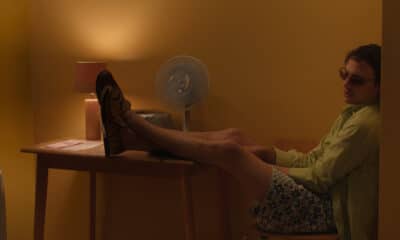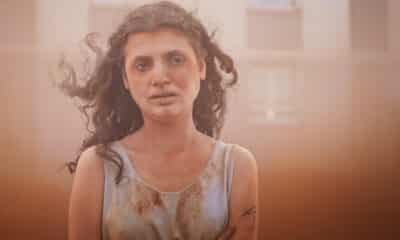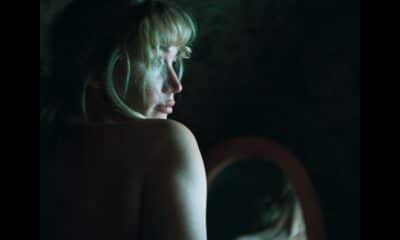Set over the evening and early hours of Friday 13th and Saturday 14th May 2022, Ehrland Hollingsworth’s Dooba Dooba is the latest film to tackle the found footage format. Told via hidden in-home security cameras, Dooba Dooba chronicles the fate of aspiring singer Amna (Amna Vegha) as she is tasked with babysitting a traumatised sixteen-year-old Monroe (Betsy Sligh). What Amna doesn’t know is that Monroe has planned a variety of ways in which to terrorise her temporary guardian, and all Hell is about to break loose.

Despite the story being set in 2022, and Amna having access to her smartphone and such, Dooba Dooba has an intrinsically 90s feel to it. This is mainly due to the quality of the video recordings that capture Amna and Monroe’s encounters. The home security unit upon which the footage has been filmed is not a high-tech modern digital one. The images are not crisp and dynamic. Instead the footage is grainy and hazy, conjuring the visual aesthetic of an old school home movie. To a modern audience, the appearance of the footage is old and alien, and so makes them feel uneasy. Even before Monroe has played her first ‘prank’, there is an air of dread that is manifested purely by the grain on the tape.
Another aspect of Dooba Dooba that unnerves the viewer is the construction of the camera angles. These shots are not perfectly framed; in fact for much of the run time the camera is either at a wide distance from Amna, or up close and distorting most of her appearance. This is uncomfortable for the audience as it is common practice to allow the viewer to be able to clearly see what is happening and who the characters are. Frame analysis is especially important in found footage films, as the audience are encouraged to read into what is displayed. In denying them this detail, director Ehrland Hollingsworth creates a tense and distressing atmosphere as – if the audience can’t properly see – how can they prepare for the nightmares that might be lurking in the background?
As with any good found-footage story, the key to Dooba Dooba is that the performances feel natural. It quickly becomes clear when the cast has over rehearsed for these types of stories, but those found within Dooba Dooba feel entirely improvised. This adds an extra frisson of danger as it feels as though even the actors don’t know what is about to happen at any given moment. These natural performances combine with the camera footage to create a truly eerie and uncomfortable atmosphere. The more Dooba Dooba progresses, the more this sensation intensifies, and by the end, audiences are likely to be a nervous wreck.
The phrase ‘dooba dooba’ is explained by Monroe’s parents as acting as something of a safe word for their daughter. Having previously experienced a terrifying home invasion, those words act as a secret word that enables the teenager to know that it is a friend, not foe, wandering the house. Whilst the phrase might be safe for Monroe, it becomes another attack on the audience who feel nothing remotely close to safe the more the words are uttered. This lack of safety is apparent at every second as Dooba Dooba is a film in a constant state of change. Just when the viewer thinks they might have it pegged, something happens to pull the rug from beneath them. Dooba Dooba starts spooky and gradually becomes more and more depraved, further separating the audience from safety – this film has great potential to become something really special.
Like Skinamirink, Dooba Dooba is one of those films that sinks into the audience’s psyche. Gripping from the outset, there is a palpable fear that runs through Dooba Dooba’s veins and will almost certainly leave the viewer with the odd sleepless night.
Dooba Dooba
Kat Hughes
Summary
Thanks to some devilish work from Ehrland Hollingsworth, Dooba Dooba has the potential to become a found-footage classic.
Dooba Dooba was reviewed at Panic Fest 2025.
Kat Hughes is a UK born film critic and interviewer who has a passion for horror films. An editor for THN, Kat is also a Rotten Tomatoes Approved Critic. She has bylines with Ghouls Magazine, Arrow Video, Film Stories, Certified Forgotten and FILMHOUNDS and has had essays published in home entertainment releases by Vinegar Syndrome and Second Sight. When not writing about horror, Kat hosts micro podcast Movies with Mummy along with her five-year-old daughter.

Latest Posts
-
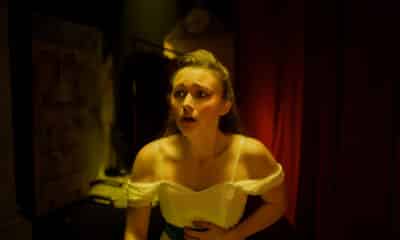

Film Reviews
/ 4 hours ago‘Fear Street: Prom Queen’ review: Dir. Matt Palmer (2025)
It has been four years since Leigh Janiak’s Fear Street trilogy took horror fans...
By Kat Hughes -
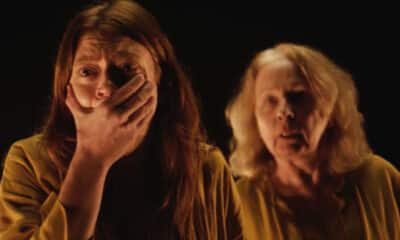

Film Reviews
/ 5 hours ago‘The Surrender’ review: Dir. Julia Max (2025)
As Julia Max’s debut feature, The Surrender, unfolds, the inspirations for the film become...
By Kat Hughes -
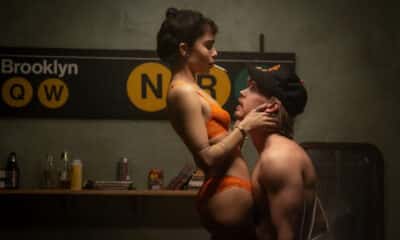

Film Trailers
/ 2 days agoFirst trailer for Darren Aronofsky’s ‘Caught Stealing’
Sony Pictures has released the debut trailer for Darren Aronofsky’s new film Caught Stealing,...
By Paul Heath -


Film Reviews
/ 3 days ago‘Lilo and Stitch’ review: Dir. Dean Fleischer Camp (2025)
Director Dean Fleischer Camp won audiences over with the fantastic Marcel the Shell with...
By Kat Hughes
